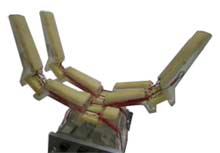A Simpler, Gentler Robotic Grip
Industrial robots have been helping in the factories for a while, but most robots need a complex hand and powerful software to grasp ordinary objects without damaging them.

Researchers from Harvard and Yale Universities have developed a simple, soft robotic hand that can grab a range of objects delicately, and which automatically adjusts its fingers to get a good grip. The new hand could also potentially be useful as a prosthetic arm.
“When you start to bring robots into human environments, all of a sudden there’s a big advantage for being compliant,” says Charlie Kemp, an assistant professor at Georgia Tech who designs home-assist robots. “You can’t always know what is where. You don’t just want to push through the world and break something. You want to have the mechanics comply.”
Other researchers have developed soft robotic hands, such as the Sensopac developed at Intel or Obrero created at MIT, but these are generally loaded with multiple types of complex sensors and motors, and require powerful algorithms to account for every joint and finger movement. In contrast, the new robotic hand has just a few sensors and a single motor, but can pick up a variety of objects with the flexibility of a human hand.
Multimedia
Watch an older video of the hand in motion.
Aaron Dollar, an assistant professor at Yale University who led the work, notes that when reaching for an object, people do not normally use a rigid grasp, but keep their fingers relaxed, so as to avoid knocking the object over. Making the robotic hand flexible allows it to pick up objects even with minor calculation errors. Embedded sensors also allow the new hand to feel an object and adjust its grip. In much the same way, says Dollar, if you reach for a coffee mug with your eyes closed, you will feel around for the best grip before picking it up.
“So basically we can start off without knowing anything about the object and reach the hand forward and through this very simple algorithm, to build up a better understanding of where the object is located,” says Dollar. The hand has recently been licensed by Barrett Technology, a company based in Cambridge, MA, that sells robotic hands for research.
“They’ve shown the hand is compliant, so you don’t have to have it as precisely positioned as you do other types of hands,” says Kemp of Dollar’s work. “The robot doesn’t have to know exactly where the object is, and in human environments, that’s really valuable.” He adds that a rigid grasp requires more precise control and execution–and therefore usually more computing power.

Dollar’s robotic hand consists of four fingers made out of a flexible, durable polymer. A single motor and spool tugs on the finger joints to open and close the hand. Each soft polymer finger contains embedded sensors, as detailed in the August 2009 online issue of Autonomous Robots. Dollar embedded two piezoelectric sensors–which report physical contact as a voltage response–into each of the four fingers through a molding process called shape deposition manufacturing (SDM). This process allows different materials to be deposited one layer at a time, so that sensors or other items can be set inside the material, which also protects those components.
“Traditional robot hand designs can be very complicated and comprise tens or hundreds of tiny parts that need to be painstakingly assembled,” says Andrew Ng, a 2008 TR35 winner and associate professor at Stanford University who works on household robots. “Dollar’s work gives robot designers a new and exciting way to build robot hands.” He adds that he is planning to apply the manufacturing technique to his own work.
“[Dollar’s] work is pushing forward on how we can have intelligent mechanics with low-level sensing and control,” says Kemp. “It will make things work better, without having to have a lot of sensing and computation. That’s exactly the type of thing we want right now, because we want robots in human environments.”
The system currently employs only one type of grasp–the “power” grip, which is useful for picking up some objects, such as a soda can, a ball, or a hammer. Next, Dollar hopes to add a “precision” grip, to enable the hand to pick up smaller objects, such as a pen.
Dollar’s former colleague Robert Howe will collaborate with Peter Allen, a professor at Columbia University, who has devised software to simplify robotic grasping, to improve the functionality of the hand. Dollar hopes the hand will eventually be used not just in robotics but also for prosthetics. Using “a stiff robotic hand to shake someone’s hand is a lot less human-like,” he says.
Keep Reading
Most Popular
Large language models can do jaw-dropping things. But nobody knows exactly why.
And that's a problem. Figuring it out is one of the biggest scientific puzzles of our time and a crucial step towards controlling more powerful future models.
How scientists traced a mysterious covid case back to six toilets
When wastewater surveillance turns into a hunt for a single infected individual, the ethics get tricky.
The problem with plug-in hybrids? Their drivers.
Plug-in hybrids are often sold as a transition to EVs, but new data from Europe shows we’re still underestimating the emissions they produce.
Google DeepMind’s new generative model makes Super Mario–like games from scratch
Genie learns how to control games by watching hours and hours of video. It could help train next-gen robots too.
Stay connected
Get the latest updates from
MIT Technology Review
Discover special offers, top stories, upcoming events, and more.